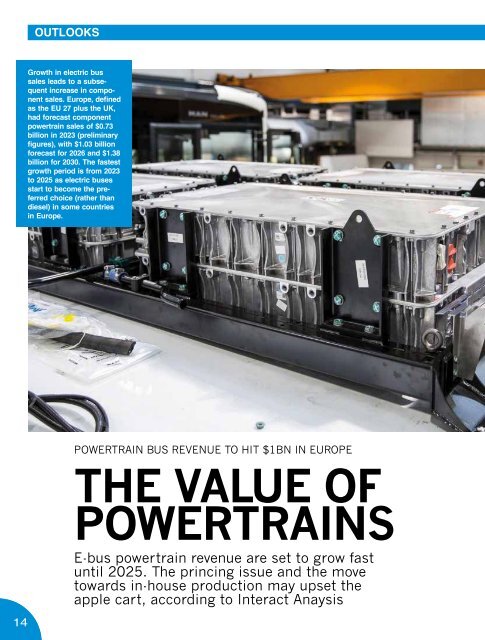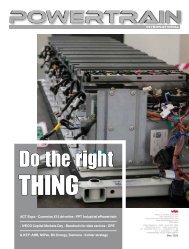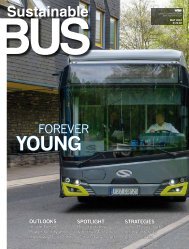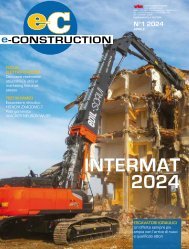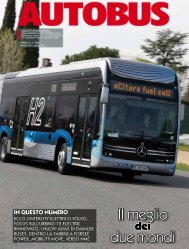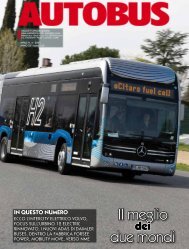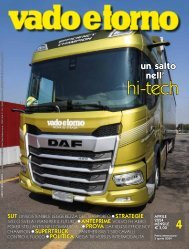2024-02 SUSTAINABLE BUS
In this issue, all the figures on the European e-bus market 2023 (hint: over 40 of the new city buses were electric!), a reporting on #battery manufacturing plans underway in Hungary and their impact on the European #electricbus landscape, a focus on powertrain values and strategies in the realm of e-mobility. Plus, a piece on the challenges faced by #BEV bus adoption in Germany (yes, it's also a matter of TCO).
In this issue, all the figures on the European e-bus market 2023 (hint: over 40 of the new city buses were electric!), a reporting on #battery manufacturing plans underway in Hungary and their impact on the European #electricbus landscape, a focus on powertrain values and strategies in the realm of e-mobility.
Plus, a piece on the challenges faced by #BEV bus adoption in Germany (yes, it's also a matter of TCO).
You also want an ePaper? Increase the reach of your titles
YUMPU automatically turns print PDFs into web optimized ePapers that Google loves.
OUTLOOKS<br />
Growth in electric bus<br />
sales leads to a subsequent<br />
increase in component<br />
sales. Europe, defined<br />
as the EU 27 plus the UK,<br />
had forecast component<br />
powertrain sales of $0.73<br />
billion in 2<strong>02</strong>3 (preliminary<br />
figures), with $1.03 billion<br />
forecast for 2<strong>02</strong>6 and $1.38<br />
billion for 2030. The fastest<br />
growth period is from 2<strong>02</strong>3<br />
to 2<strong>02</strong>5 as electric buses<br />
start to become the preferred<br />
choice (rather than<br />
diesel) in some countries<br />
in Europe.<br />
POWERTRAIN <strong>BUS</strong> REVENUE TO HIT $1BN IN EUROPE<br />
THE VALUE OF<br />
POWERTRAINS<br />
E-bus powertrain revenue are set to grow fast<br />
until 2<strong>02</strong>5. The princing issue and the move<br />
towards in-house production may upset the<br />
apple cart, according to Interact Anaysis<br />
The revenue from powertrain components<br />
is forecast to reach a billion<br />
US dollars in 2<strong>02</strong>6 in Europe<br />
(and a billion euros in 2<strong>02</strong>7 at the<br />
present exchange rates), according to Interact<br />
Analysis’ latest research. This is for<br />
BEV buses only, which dominate, and excludes<br />
a smaller amount of business in electrified<br />
hybrid and hydrogen buses.<br />
The fastest growth period is from 2<strong>02</strong>3 to<br />
2<strong>02</strong>5 as electric buses start to become the<br />
preferred choice (rather than diesel) in some<br />
countries in Europe. In countries with strong<br />
government support, battery electric buses<br />
have reached a point where they can be very<br />
successful, as product availability, low running<br />
cost and clean air targets should combine<br />
to see a lot of sales. Some places, such<br />
as the Netherlands and much of Scandinavia,<br />
already see battery electric as the default<br />
choice for a bus and we expect that this will<br />
steadily become the case in other countries<br />
over the next few years, including France,<br />
Germany and the UK.<br />
Electrification spreading in Europe<br />
It is not just Western Europe that is seeing<br />
bus electrification though. Eastern Europe is<br />
not necessarily slower and has seen some<br />
very significant deals, so understanding<br />
where growth will be faster and where it will<br />
be slower is arguably a case of analyzing<br />
country by country and city by city rather<br />
than looking at regions within Europe.<br />
From 2<strong>02</strong>6 we forecast slower growth for<br />
electric buses as some cities and countries<br />
will already have a high percentage of new<br />
buses electrified by 2<strong>02</strong>6.<br />
This growth in electric bus sales leads to a<br />
subsequent increase in component sales.<br />
Europe, defined as the EU 27 plus the UK,<br />
had forecast component powertrain sales of<br />
$0.73 billion in 2<strong>02</strong>3 (preliminary figures),<br />
with $1.03 billion forecast for 2<strong>02</strong>6 and<br />
$1.38 billion for 2030.<br />
Europe to stay behind China<br />
China already has a >$3 billion annual powertrain<br />
component market for buses (referring<br />
here to components sold for buses registered<br />
within China, not sales of Chinese<br />
buses or components to Europe). This is due<br />
to a much higher percentage of new buses<br />
being electric, so Europe will still be well behind<br />
China, even in 2<strong>02</strong>6. However, electric<br />
buses in Europe are becoming more common<br />
than in many other parts of the world.<br />
Of the total bus sales per year in Europe (40-<br />
50,000), we expect over 14,000 to be electric<br />
in 2030. This is mainly due to low adoption<br />
of electrification for rural and intercity buses.<br />
Urban buses will predominantly be battery<br />
electric by 2030, in line with negotiations<br />
at EU level (not yet concluded at the time<br />
of printing this magazine issue) for full zero<br />
emission city bus market in 2035 with intermediate<br />
target of 90% in 2030.<br />
China also has much lower component<br />
pricing than Europe. If Chinese companies<br />
manage to make inroads into the<br />
European market for completed battery<br />
packs (rather than just cells), motors and<br />
other products, prices could fall. In the<br />
long term, Chinese companies may be<br />
capable of winning a high share.<br />
However, at the moment, the political environment,<br />
the time to setup operations, and<br />
the fact some companies are not yet well<br />
Interact Analysis is a<br />
market research firm with<br />
a specific department for<br />
truck, bus and off-highway<br />
electrification. Here on<br />
Sustainable Bus Magazine<br />
we host a contribution<br />
from the research analyst<br />
Jamie Fox.<br />
known, means that in the next few years<br />
the share of Chinese companies will remain<br />
low for many products. However, the price<br />
gap is very large – as more people come<br />
to understand that Chinese products can<br />
be half price rather than 10% less – these<br />
products may eventually start to command<br />
attention. However, of course these are<br />
prices for sales within China. As Chinese<br />
companies have to pay for overseas sales<br />
and marketing, travel to Europe, shipping<br />
and the costs of complying with European<br />
regulations the price advantage does reduce<br />
substantially, but even so, Chinese products<br />
are likely to remain significantly less expensive<br />
than those from most other countries<br />
including from within Europe.<br />
Leading battery pack providers for on-road<br />
vehicles (including trucks and sales outside<br />
Europe) ranked in Interact Analysis’ 'Electrified<br />
truck and bus components – 2<strong>02</strong>3'<br />
report include BorgWarner (Akasol), BMZ,<br />
BYD, CATL, Forsee Power, Northvolt,<br />
SAFT and Xalt Energy. These companies<br />
have expanded their offerings, however the<br />
market is quite diverse and there are many<br />
smaller suppliers in-play with no single<br />
dominant company.<br />
For other components, ZF has excelled for<br />
several years with its portal axle products,<br />
although it currently faces strong competition<br />
in buses from central drive designs.<br />
Bosch is another company well placed to<br />
address the market for powertrain components<br />
in electric vehicles in on-road vehicles.<br />
There is also still time for new entrants<br />
to disrupt the market or for existing players<br />
to carve out a strong niche.<br />
A in-house trend?<br />
In addition, there are also some companies<br />
that produce components in-house<br />
(i.e. vehicle manufacturers that produce<br />
their own components). Interact Analysis<br />
forecast’s this trend to grow, with inverters,<br />
battery packs and PDUs being some<br />
of the components that are increasingly<br />
being planned for in-house production<br />
14<br />
15


